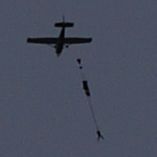Recommended Posts
riggerrob 644
"
.................................................................
It depends which angle you pull the ripcord.
If you pull the ripcord in line with the housing, it will not do any damage.
OTOH if you pull the ripcord at an odd angle, it might abrade the end of the housing, creating rough edges that can be sanded off ... by a rigger.
Andy9o8 3
Quote"I heard from a rigger repacking my reserve that every time the handle is pulled, there is slight wear on the metal which increases the pull force. He therefore smoothed it out for me - I don't know what tools he used but I'm guessing it was similar to sandpapering wood, whatever the equivalent to metal is.
"
.................................................................
It depends which angle you pull the ripcord.
If you pull the ripcord in line with the housing, it will not do any damage.
OTOH if you pull the ripcord at an odd angle, it might abrade the end of the housing, creating rough edges that can be sanded off ... by a rigger.
Is that really all that much an issue with a reserve cable housing with a few pulls on it? I'm thinking back to when rigs had main ripcords that would have many hundreds of pulls without issues with the housing.
billvon 3,176
>few pulls on it?
Usually not. Damage from things like dragging the container during packing is, IMO, more of an issue.
>I'm thinking back to when rigs had main ripcords that would have many
>hundreds of pulls without issues with the housing.
Often the main ripcords were teflon coated, greatly minimizing wear.
ficus 0
In experimenting with various directions to pull a cutaway handle, I've noticed that some more downward ones (mostly inline with the cable housing) tend to promote more of a peel of the velcro than punching straight out, the somewhat famous cause of more than a few hard cutaways.
JohnMitchell 16
We always train to pull any handle in the direction the housing runs. Any other method is less effective, as you now know. Pulling at a 90 degree or greater angle greatly increases pull forces. I made a lot of ripcord jumps, and never noticed wear on my main ripcord. I did notice the direction I pulled made the biggest difference. ![]()
format 1
I couldn't pull with one hand two years ago.
Until now I thought the non-adjusted gear was the reason why (handles to high, near neck - small force)
I'm sure I pulled afront - 90 degrees of housing..
Tnx for the angle![]()
chuckakers 426
QuoteQuote...mine works in any direction.
Correct. Except for the friction between the cable and the edge of the housing, which should be very low, the cable doesn't know which direction the handle is being pulled. It pulls the pin the same. Certainly, if you pulled it 180 degrees in the wrong direction, back in the direction of the housing, that would be the most friction and the hardest pull. But the system is designed to function with a wide variety of pull directions.
Straight down in line with the housing is the most efficient, but straight away from the body is the direction with the most muscle power available in the average body. There are a lot of variables. The regs state that the pull force should not exceed 22 lbs. I believe that is measured in a straight - inline with the housing - pull.
Kevin K.
I agree. After all, we're not talking about a blast handle here (don't ask, kids).
D-10855
Houston, TX
gainer 0
A comment, another factor which can play a role is the velcro holding the handle. If you do not peel the handle then I found that it becomes a lot more difficult to pull in either direction.
chuckakers 426
QuoteIt was a Mirage G4, with a soft handle, on with velcro. The rig has less than 50 jumps on it.
A comment, another factor which can play a role is the velcro holding the handle. If you do not peel the handle then I found that it becomes a lot more difficult to pull in either direction.
While I have never peeled the velcro before dumping on my 7 reserve rides, I do know many people that train using a peel and pull technique. So do you think not peeling the handle first contributed to the hard pull?
And was it a pillow style or loop soft handle?
D-10855
Houston, TX
I've been told that if I practice weakly then I'm likely to do that when I'm in real need of EPs. Could this have been a factor? I always do my EP practice with vigor based on this advice. ![]()
hackish 8
I will redo the loop if it's at 22lbs and I generally aim for about 10-12 if the owner is a a small woman. A few more if she's feisty and has red hair.
-Michael
Scrumpot 1
QuoteThe sealing thread about 4.75lb and there are generally 2 strands so you're looking at a total maximum of 31.5lbs pull force.
Please tell me where you get these #'s and your extrapolated theory? If the sealing thread is a part of the friction load holding the pin in place in the 1st place, then it is not installed correctly. Otherwise, the snatch/break force "fail point" of the sealing thread is not linearly cumulative (ie does not add to) the overall pull force required to move the pin from the reserve closing loop, in deploying a reserve.
C'mon now. Puhleeze. I wish people would not espouse as if FACT, these sorts of theories which otherwise, they clearly have no real knowledge.
EDIT to add:
P.S. I see in your profile that you are a Senior Rigger. So if it is me who with this is wrong - please, educate me. (seriously)
gainer 0
Definately, velcro is at its strongest when it is on top of each othe and is pulled sideways
And was it a pillow style or loop soft handle?
Pillow, my other three were with a metal loop and they were easier to get out
billvon 3,176
>1st place, then it is not installed correctly.
Worst case:
Pin is inserted and moved around/measured to make sure it's <= than 22lbs. Pin is sealed with some slack. (It's impossible _not_ to leave some slack with most seal presses.) Jumper puts rig on, moves around a lot, has a hard opening etc and eventually the pin moves until all the "slack" in the sealing thread is taken up. It may now contribute to pull force.
In practice, most reserves settle a bit with time* and the tension on the pin goes down anyway so it's not a big deal. However, if you're worst-casing it, that's what you might see.
(* - may not be true with Optimums.)
ficus 0
QuoteQuote
And was it a pillow style or loop soft handle?
Pillow, my other three were with a metal loop and they were easier to get out
I think you may have gotten hung up on your velcro. You don't really need to peel a D-ring to the extent you do a pillow, because you have this bar of metal pulling the velcro apart as you yank on it. Of course, peeling doesn't hurt :)
Punching forward with a pillow type handle without peeling is going to take a lot more force. Punching downward has an inherent peeling motion. (Try it sometime with your cutaway handle.) So it might not have been friction on the ripcord.
Scrumpot 1
But then again, I am not a rigger. So please feel free to correct wherever you feel my thinking on this may be misguided.
billvon 3,176
>considered the "standard" whereby I would be purposefully reducing pre-sealing
>pull tensions on people's rigs because of it!
I didn't say that. I said worst case that's what could happen.
Scrumpot 1
I don't think people should go away from here fearing that their rigger's seal thread is actually adding pull force to their reserve, to the extent that it should really even be a concern, let alone a consideration, as the OP seems to want them to, do you?
On the whole, bottom line, the impression given (or that can be taken) from post #16 is I think, incorrect. Again, please feel free to correct me if it is I, that am instead mistaken.
Post #16's Statement: The riggers seal thread ADDS 4.75lbs of pull force to the reserve-pull, per turn of thread (commonly x2).
My Statement: That is incorrect! And unless the thread is being used to structurally tie-down the pin to the closing loop somehow (ie: is installed incorrectly) it does NOT add significant pull force (aside from your "WCS") to the reserve-pull at all.
Which statement is correct?
billvon 3,176
>for and COMPENSATES for the sealing-thread added pull-force, as part of his
>standard routine.
Right, which results in a lower pull force total. That can be a good idea on smaller women; we had one woman (very small and rig didn't fit great) who had a tough time getting her reserve out.
>I don't think people should go away from here fearing that their rigger's seal
>thread is actually adding pull force to their reserve, to the extent that it should
>really even be a concern, let alone a consideration, as the OP seems to want them
>to, do you?
I don't think it's a concern for _most_ people. Even if it adds a few pounds it's not going to matter.
However, it is important to realize that that 22 lbs is not a guarantee. Dirt in the housing, an off-angle pull, seal thread, a hit to your reserve, even errant labels can cause a harder than expected pull. Which is one reason it's a good idea to pull your reserve occasionally (i.e. right before a repack) to see what the force is like.
QuoteHowever, it is important to realize that that 22 lbs is not a guarantee.
The 22 lb. is an arbitrary figure that is used for testing under ideal condition. A rig can be packed today and tomorrow exhibit a pull force less than 22 lb. or greater then 22 lb.
Sparky
4.3.2.4 Primary Actuation Device/Ripcord, Actuation Force Tests: A load at the ripcord handle, or equivalent, of not less than 5 lbf (22.2 N), applied in the direction giving the lowest pull force, nor more than 22 lbf (97.9 N), applied in the direction giving the highest pull force under normal design operations, shall result in a positive and quick deployment initiation on all tests. A minimum of 10 pull tests is required. For chest type parachute assemblies, the maximum pull force shall be 15 lbf (66.7 N).



.thumb.jpg.4bb795e2eaf21b8b300039a5e1ec7f92.jpg)







I may be remembering things incorrectly, as I know near to nothing about these things....but...

I heard from a rigger repacking my reserve that every time the handle is pulled, there is slight wear on the metal which increases the pull force. He therefore smoothed it out for me - I don't know what tools he used but I'm guessing it was similar to sandpapering wood, whatever the equivalent to metal is.
I initially only got the "practise pull" for the repack on the second go being surprised how hard it was (though I guess I didn't have the adrenaline of a mal). It was easier after he had worked on it, either because it had improved or because I was prepared for a hard pull.
I mentioned this to another rigger who thought it was crazy.
Any riggers reading this? Would be nice to have more input .
Share this post
Link to post
Share on other sites